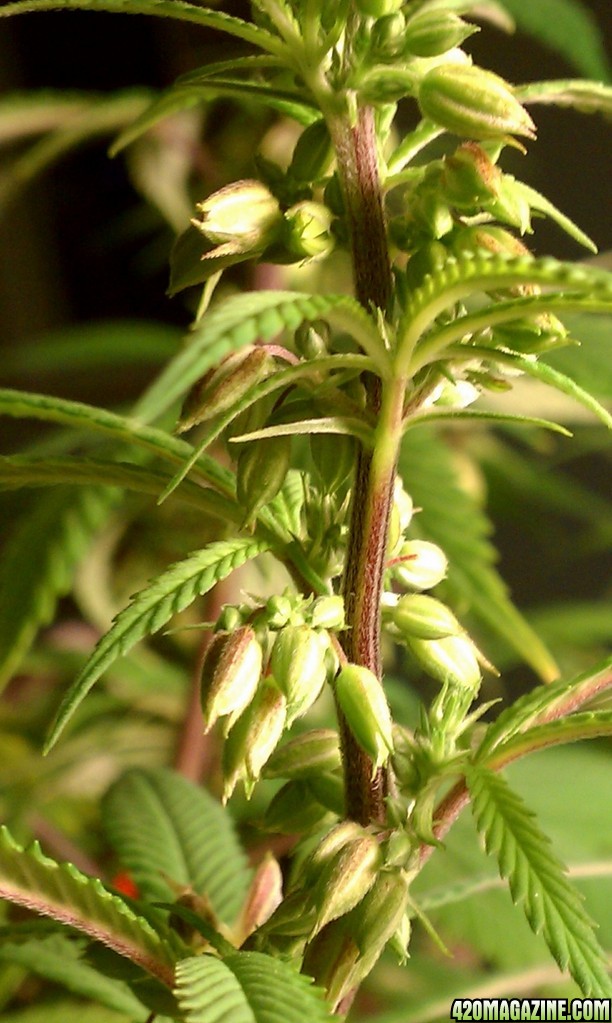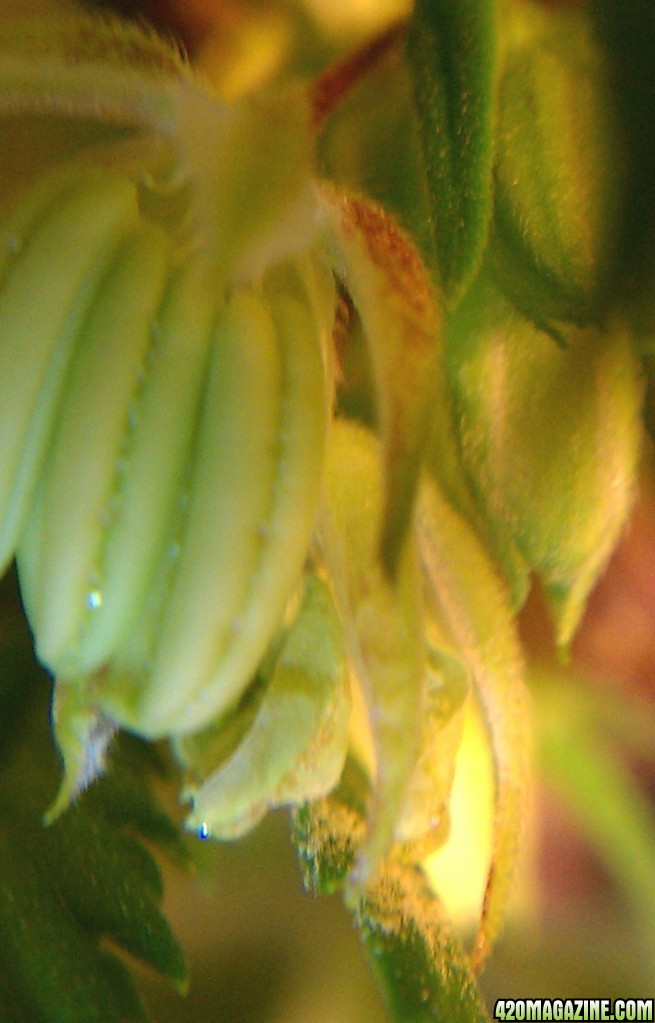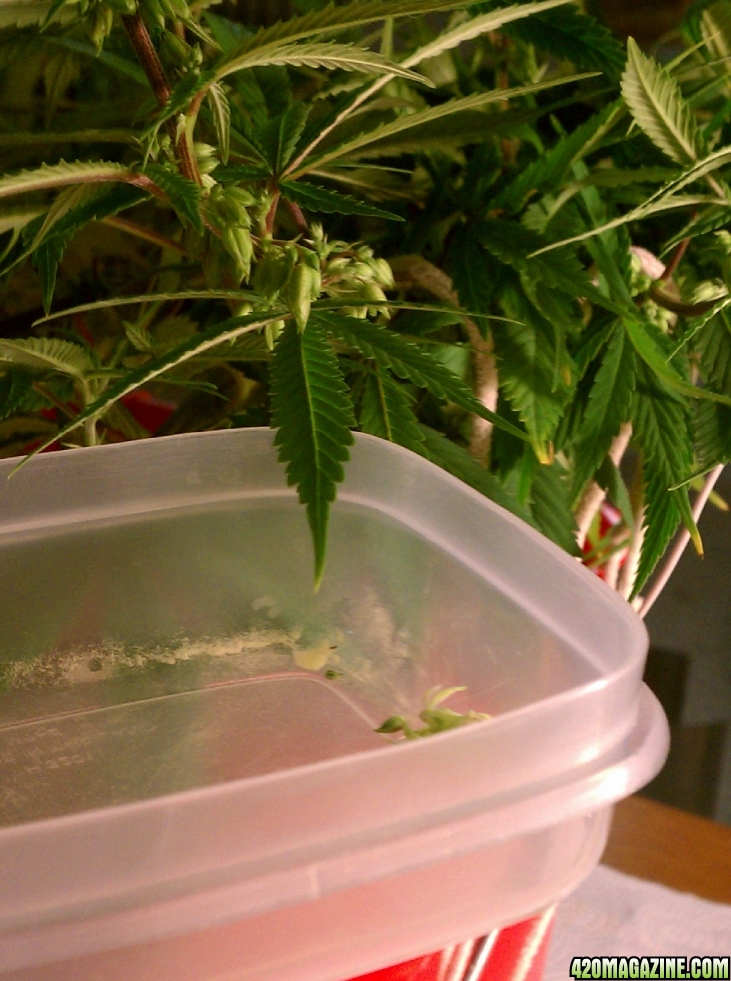This is a post from 2007
I am currently researching the pollen collection process to perform on my own plants.
__________________________________________
I decided to take my own pollen after reading up on it and here's what I did:
First a pic of a maturing branch:

Here is a close up of the male flower and the bananas releasing the pollen on a leaf:

I lined my surface with paper towels, place a tupperware bowl under a branch and gently tapped it to release the pollen:

This will be done a few more times throughout about a week as the rest of them mature and open up.
I am currently researching the pollen collection process to perform on my own plants.
Medical Marijuana;615481 said:How to take and use pollen:
This is a simple method of collecting and administering pollen to your female plants in a shared environment.
Collection
As the picture shows, this male plant is raring to go. (My totally simple pollen collection technique in action.) I recommend doing this only after you have closed the ladies up for the night. Shut off any fans in the vicinity, as pollen is an airborne 'agent' and will travel for quite some distance if allowed.
Also be considerate of household members that are sensitive to pollen
1) Place a dry, sterile, open bag/container under the opening male flowers.
2) Gently tap the stem with a finger. The pollen will slowly settle into the container. (If you are careful, only a few flowers will fall into the mix.
3) Remove any flower/plant parts that land in your container with the pollen. Tap them off gently before removing, to recover the pollen. (Moisture = BAD)
4) Dilute pollen with sterilized flour at a four-to-one ratio. This will allow more coverage if required (Optional)
5) Refrigerate until use. (Viable for around 3-5 days)
6) Immediately change your clothing and clean up before going near your female plants.
[Also, it is a good idea to isolate your pets during this time. I had a cat run in once when I was collecting pollen and after I chased it out, it promptly ran downstairs and into my Flowering room. A month later I had some very unusually crossed beans]
This is a real easy and practical method for harvesting a small amount.
Pollination disclaimer: This method is not recommended for everybody. Cross-pollination is often a result of pollinating plants in the presence of other females. Proceed at your own risk.
Due to weak branches, space and size considerations, etc., it may be necessary to pollinate your plants without removing them from the others. If possible, I would advise removing the female to be fertilized prior, but when that isn't possible, this is a good alternative.
Step 1
Wait till the grow lights go off as scheduled, and shut down all of the fans. Adjust your timers to eliminate 'surprises'. Eliminate any drafts in the outer and adjoining room and shut off your furnaceAC. The room must have zero air movement before you begin. Place a small garbage bag in a pocket at this time, later you can put all of the pollen 'tools' inside it when finished.
Step 2
Strategically locate the female(s) to seed next to each other and against a wall earlier in the grow. Now prepare a clear plastic drop cloth to isolate these plants from the rest of the garden. The plastic featured here is 4' high and 7' long.
Tape a straight edge against the far side of the tarp so that you can anchor it against the wall securely. You do not want it to come down! Use the thinnest plastic you can find to avoid excess moisture and damage to the plants. Because it is thin, be very careful to avoid damaging it.
Step 3
After arranging your divider by draping it loosely between the plants, (do not anchor it yet), mist the floor, net pots and buckets with distilled water. This will neutralize any errant pollen that drifts by or lands on the floor.
Thoroughly mist the other plants that you do not want to pollinate, being careful to avoid blowback on the plants to be fertilized.
Step 4
I prefer to wear tight-fitting clothes during this procedure to reduce pollen transfer. Carefully retrieve the pollen container, put the brush inside (a Q-tip will work for smaller amounts.) and place it into a larger, clean, storage bag. After sealing it shut, wipe the outside with a damp cloth to remove any pollen. This is important, you do not want any pollen to escape during the trip to the selected plants.
Step 5
Select the branches that you intend to fertilize and label them with computer labels. This will aid in identification later. Avoid going overboard here. A single MJ plant is capable of producing several thousand beans; only pollinate a few depending on your needs.
Make sure that the branches to be pollinated are in an area that will get good light coverage. Avoid pollinating the extreme lower branches, as they will likely not mature into viable seeds.
Step 6
While wearing gloves, position the bags nearby and below the branch and lightly coat the paintbrush with pollen. While holding the brush a short distance (3-6") above the target bud, lightly tap the brush, releasing pollen onto the fertile flower(s) below.
Do not contact the flowers directly with the brush. The 'tap' is similar to tapping off the ash on a joint, be careful, a little pollen goes a long way. For interior buds, simply tap the end of the brush lightly against the stems.
Try to select branches that are nearest to a wall, to avoid direct contact with other non-pollinated branches. Cross-pollination will occur anyway, but usually only a few extra seeds are a result.
Step 7
When you are satisfied with the coverage, seal up the inner bag, remove your gloves carefully and place them in the larger zip lock before sealing it as well. Now place the bag into the clean garbage bag that was previously secured in your pocket.
You may wish to remove your shirt slowly and place it in the bag as well.
Keep a wet washcloth nearby to wipe off your face, arms, legs and other pollen magnet areas. Doing this will reduce the spread of pollen as you leave the area. Remove the pollen bag from the room and return after washing up.
Step 8
Secure the far end of the plastic barrier to the wall. Be careful to do this slowly to avoid stirring up the air/pollen. Secure the end closest to the door using squares of stiff cardboard and tacks. These are essentially homemade roofing felt nails and will prevent the plastic from tearing.
Now shut them in for the night, making sure that the fan(s) are still disabled. You may need to raise the lights during the lights on period to compensate for the lack of fans.
This continues for 48 hours. On the third day's lights off time, mist the fertilized plants thoroughly to take out any viable pollen that remains behind, in the morning turn on the fans and adjust the light(s) as normal.
Remove the plastic divider after one week when you are certain that there is no contamination threat.
Remember at the end of the grow to thoroughly clean your grow room with a damp cloth to remove all traces of pollen.
Four to five weeks later, you should have a bunch of viable beans to grow or share with your friends and nature.
__________________________________________
I decided to take my own pollen after reading up on it and here's what I did:
First a pic of a maturing branch:

Here is a close up of the male flower and the bananas releasing the pollen on a leaf:

I lined my surface with paper towels, place a tupperware bowl under a branch and gently tapped it to release the pollen:

This will be done a few more times throughout about a week as the rest of them mature and open up.


